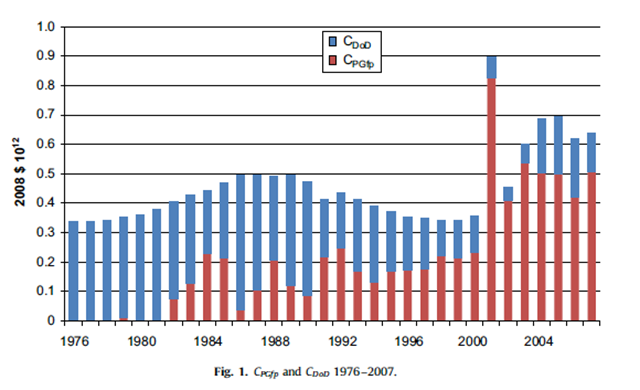Graph of the Day: Annual Cost to the U.S. Military of Defending the Flow of Oil from the Persian Gulf, 1976-2007
By Mark Thompson
24 April 2011 … While working on a recent piece on how to cut $1 trillion from the $7-trillion-plus U.S. defense budget over the coming decade, I stumbled upon a provocative analysis by Roger Stern, an economic geographer at Princeton University. He says the U.S. has “mis-allocated” — others might say “wasted” — $8 trillion since 1976 protecting the oil flow from the Persian Gulf that fuels much of the global economy. Especially since in 2010, when the U.S. was the destination of less than 10 percent of the oil flowing out of the Gulf. The U.S. has insisted, since the days of the Carter Administration, that the oil flowing out of the Persian Gulf is a vital national-security interest of the U.S. Beyond that, Presidents and the Pentagon have said, the narrow Strait of Hormuz is a vulnerable bottleneck for shipping headed out of the Gulf. Any troublemaker — especially Iran — could bring the U.S. and world economies to their collective knees by shutting it down by sinking a couple of tankers as they pass through. Consequently, the U.S. has poured tons of money into the region since then, including three wars. It has bulked up its military forces in the neighborhood — including the U.S. Navy’s 5th Fleet, headquarters in Bahrain, smack dab in the middle of the gulf — to keep the oil flowing. Balderdash, says Stern. He uses more technical terms, but his bottom line is the same: Iran and other nations in the region have just as much, if not more, need to keep the oil flowing than the U.S. Think of it as your right hand — angry at your left hand for some casus belli — pinching their shared aorta to punish the left hand. Both would quickly begin turning blue. More critically, Stern argues, the U.S. military’s emphasis on the Gulf has diverted precious defense resources away from the western Pacific, where China poses a far graver long-term threat to American interests. “On an annual basis, the Persian Gulf mission now costs about as much as did the Cold War,” Stern says in his paper, which appeared in Energy Policy, a peer-reviewed scholarly journal, in April 2010 to scant notice. He also suggested it could be costly in more ways than one: “Without the extensive long-term US military presence in the Persian Gulf, it seems an open question whether anti-US suicide terrorism such as the USS Cole and 9/11 attacks would have taken place.” Stern’s paper pegs the cost of the U.S. military presence in the Gulf from 1976 to 2007 at $6.8 trillion. Last week, he estimated — at Battleland’s request — that the cost through 2010 was about $8 trillion. …

more like the annual cost to the US tax payer. LOL
makes gas seem even more expensive doesn't it?
great blog BTW!